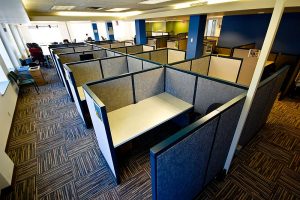Investing in thoughtful cubicle design is not just about aesthetics; it’s about creating a workplace where employees can thrive.
In the high-pressure environment of call centers, productivity and employee well-being are paramount. The design of call center cubicles plays a crucial role in shaping the psychological and emotional experiences of employees, which in turn affects their performance. By understanding and applying principles from environmental psychology, call centers can create workspaces that enhance productivity, job satisfaction, and overall mental health. Here’s an exploration of the psychological aspects of call center cubicle design and how to create a productive environment.
1. The Impact of Space and Layout
- Open vs. Enclosed Spaces: The layout of a call center can significantly influence employee behavior and feelings. Open layouts promote collaboration and communication but can also lead to distractions and noise. Enclosed cubicles offer privacy and focus but might make employees feel isolated. A balanced approach that includes both open areas for teamwork and private cubicles for focused tasks can cater to diverse needs.
- Proximity and Accessibility: The distance between cubicles and shared resources (like printers, break rooms, and supervisors’ offices) affects efficiency and communication. Designing a layout that minimizes unnecessary movement and makes essential resources easily accessible can boost productivity and reduce stress.
2. Personalization and Control
- Personal Space: Allowing employees to personalize their cubicles can enhance their sense of ownership and control over their workspace. Personal items like photos, plants, and decorations make the environment more comfortable and less sterile, which can positively impact mood and motivation.
- Environmental Control: Providing employees with some control over their environment, such as adjustable lighting and temperature, can reduce discomfort and enhance satisfaction. Small adjustments like dimmable lights or personal fans can make a significant difference in individual comfort levels.
3. Lighting and Color Psychology
- Natural Light: Exposure to natural light is linked to improved mood, alertness, and productivity. Whenever possible, design cubicles to maximize natural light through windows and skylights. If natural light is limited, full-spectrum LED lighting can be an effective alternative.
- Color Schemes: Colors can have a profound psychological impact. Cool colors like blue and green are calming and can help reduce stress, while warm colors like yellow and orange can boost energy and creativity. Neutral colors can provide a balanced background that is easy on the eyes. Choosing the right color scheme for cubicles can create a conducive environment for different types of tasks.
4. Acoustic Management

- Noise Levels: Excessive noise can be a major distraction and source of stress in call centers. Using sound-absorbing materials for cubicle walls, ceilings, and floors can help reduce ambient noise. Acoustic panels and white noise machines can also improve the auditory environment, making it easier for employees to focus on their tasks.
- Privacy: Ensuring that conversations are not easily overheard can reduce stress and increase a sense of privacy. High cubicle walls and strategically placed sound barriers can help maintain acoustic privacy while still allowing for necessary communication.
5. Ergonomics and Physical Comfort
- Ergonomic Furniture: Providing ergonomic chairs and desks is essential for physical comfort and health. Adjustable furniture that supports good posture can prevent musculoskeletal issues and reduce fatigue. Ergonomic accessories like keyboard trays, monitor stands, and footrests can further enhance comfort and productivity.
- Movement and Flexibility: Encouraging movement and flexibility in the workspace can combat the negative effects of prolonged sitting. Sit-stand desks, stretching zones, and policies that promote regular breaks can help maintain physical health and mental alertness.
6. Environmental Psychology and Well-being
- Biophilic Design: Incorporating elements of nature into the workspace, known as biophilic design, can improve mental health and well-being. Plants, natural materials, and nature-inspired artwork can reduce stress and increase satisfaction. Views of nature, even through images, can have a calming effect.
- Social Spaces: Providing spaces for social interaction and relaxation can improve morale and reduce burnout. Break rooms, lounges, and collaborative areas where employees can interact informally help build a sense of community and support.
7. Clear Signage and Organization
- Wayfinding: Clear signage and an organized layout can reduce confusion and stress. Ensuring that employees can easily navigate the workspace and find necessary resources quickly can enhance efficiency and satisfaction.
- Clutter Management: A cluttered workspace can be distracting and overwhelming. Providing ample storage solutions and promoting a clean desk policy can help maintain an organized and tidy environment, which supports focus and productivity.
Conclusion
The design of call center cubicles has a profound impact on the psychological and emotional well-being of employees. By incorporating principles of environmental psychology, such as optimizing space and layout, allowing personalization, managing acoustics, ensuring ergonomic comfort, and integrating elements of nature, call centers can create productive and positive work environments. Understanding the psychological needs of employees and designing spaces that support those needs can lead to higher productivity, increased job satisfaction, and overall better mental health. Investing in thoughtful cubicle design is not just about aesthetics; it’s about creating a workplace where employees can thrive.


Join the conversation!